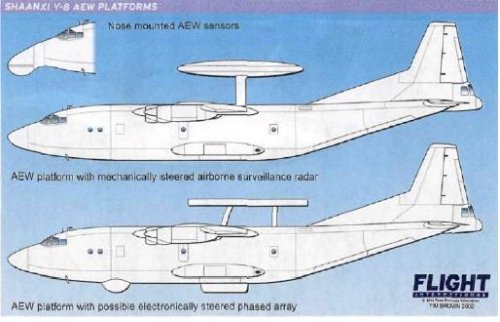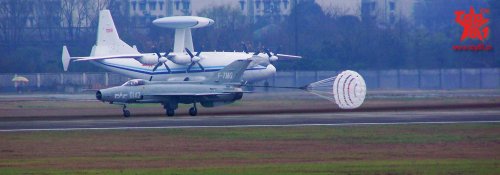One of the KJ-200 (Y-8W?) AWACS prototypes wearing a naval camouflage color scheme is shown here. This so-called "Balanced Beam Testbed" bears some resemblance to the Swedish Saab 340 AWACS aircraft with its electronically scanning phased array radar inside a large rectangular fairing carried above the fuselage. The radar is likely to be the product of the 38th Institute. The first Y-8 "Balance Beam Testbed" prototype took off on November 8, 2001 at SAC, after converted from a Y-8F-200 transport aircraft. The production version (formally named as KJ-200) is based on the new Y-8 "Catagory III Platform" which has a redesigned fuselage with a solid nose and a new tail section with the loading ramp removed. Two radomes are located at the nose tip and tailcone which may house additional antennas to provide full 360° coverage. More fairings can be seen at the wingtips and top of the tailfin as well. It also has an integrated wing fuel tank and 4 high-efficiency JL-4 6-blade propellers giving the aircraft a longer range and less noise. A C3I center is housed in a pressurized carbin, and a new integrated digital avionics system based on ARING429 and RS422 databus has been installed. This new type first flew on January 14, 2005 at SAC. Both KJ-200 and KJ-2000 have demonstrated China's determination to acquire indigenous AWACS capability after the earlier A-50I setback. They are expected to coordinate J-7G, J-8F, J-10A, J-11A, JH-7A and H-6H/M via datalinks in the possible air compaigns against Taiwan. Two prototypes had been evaluated by PLAAF (30x7x?). However #2 KJ-200 crashed on June 3, 2006 due to wing surface icing -- a serious blow to the indigenous AWACS effort. The latest information (November 2007) suggested that an improved KJ-200 has been built at SAC.









